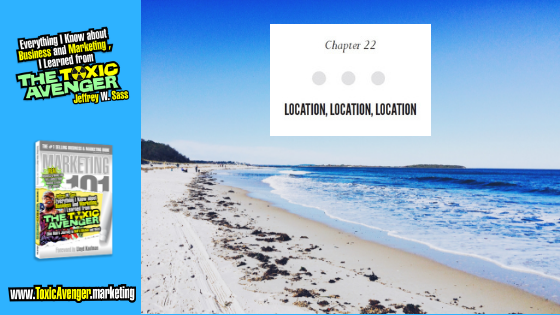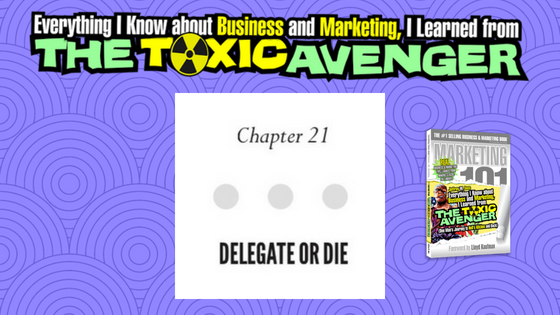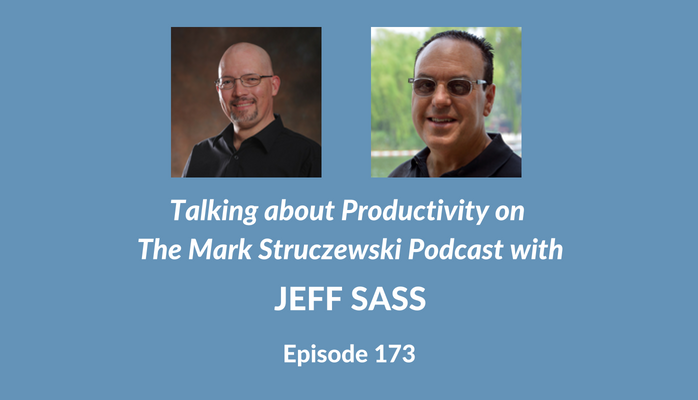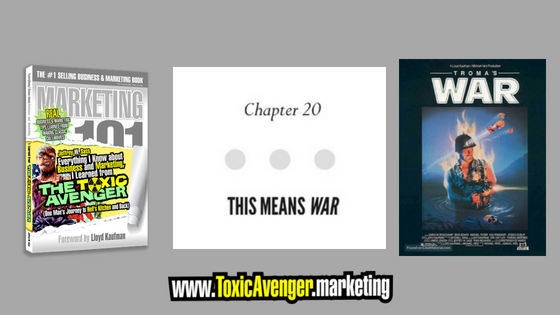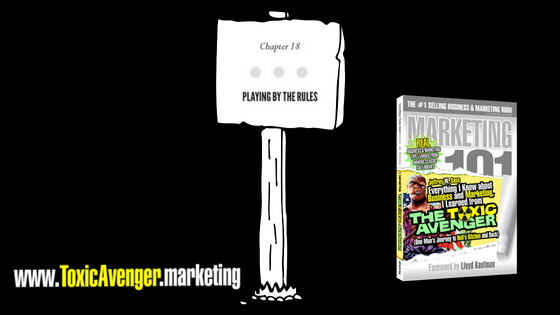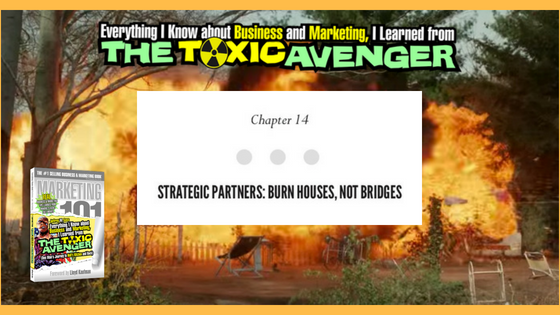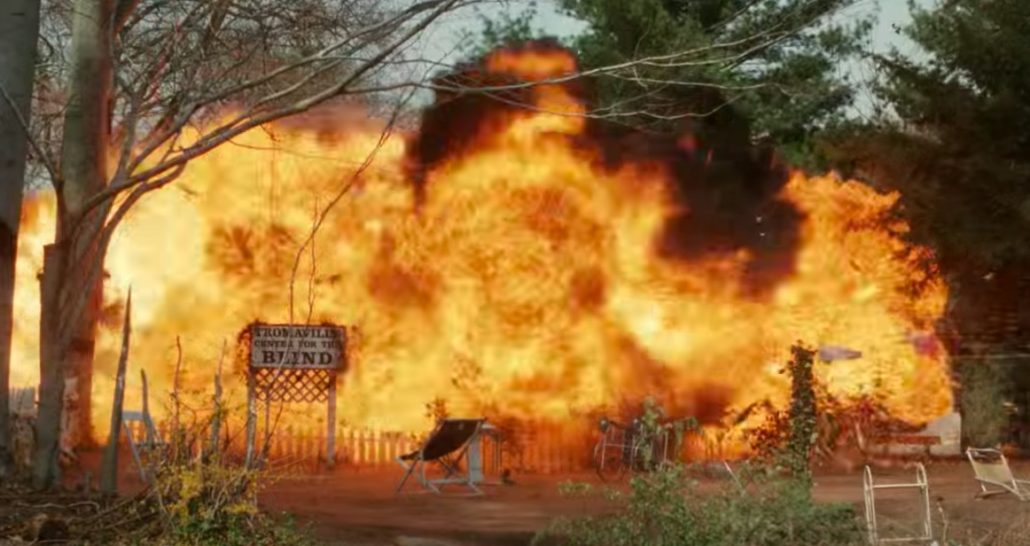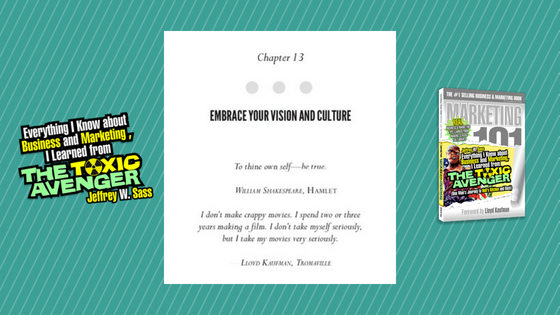Chapter 23: Everyone is Expendable (Especially if you Wear a Mask)
Greetings from Tromaville! Here is Chapter 23 of my book, Everything I Know about Business and Marketing, I Learned from THE TOXIC AVENGER. This chapter shares a lesson about dealing with talent (i.e. employees) and their unique quirks, and recognizing that everyone is expendable… even you and me.
If you haven’t done so already, you can read the Foreword by Troma co-founder, Lloyd Kaufman, and the Introduction to the book as well as Chapter 1, 2, 3, 4, 5 and 6, 7 ,8, 9, 10, 11, 12, 13, 14, 15, 16, 17, 18, 19, 20, 21 and 22. You can also see me read a few chapters live, along with Lloyd and Toxie, at Florida Supercon as well as a few chapters I read on Facebook Live. Stay tuned for additional chapters to be published here. If you like what you read and can’t wait for more, please don’t be shy. You can buy the book now on Amazon (and also please don’t be shy about sharing, and reviewing the book when you do read it.) Both Toxie and I greatly appreciate your support! – Jeff Sass
NOTE: Earlier this year, and subsequent to the publishing of this book, the talented John Altamura passed away unexpectedly. John shared the role of The Toxic Avenger and is referenced in this chapter. His contributions to Troma and these films will never be forgotten, and my condolences go out to all of his family, friends, and fans. R.I.P. John.
Chapter 23: Everyone Is Expendable (Especially if you Wear a Mask)
Dealing with “talent” is a special skill in and of itself. Like it or not, “talent” is special, and often for the best results, you need to treat them special. Fortunately, by the time I made it to Tromaville, I had a good sense of this, having produced the early cable TV show Celebrity when I worked at Satori. The hostess of that show was the great NY disc jockey Alison “ The Nightbird” Steele. When I worked with Alison, she was already a celebrity in her own right, one of the first female FM radio DJ’s to make it big on the prestigious NY City Classic Rock station, WNEW. For the show, we often had to show up at various hotels to interview famous actors and actresses in town to promote their latest movies. Everyone, from Jane Fonda to Robin Williams, to Christopher Reeve, and countless other A-list stars of the day.
Alison was a pro, and wonderful to work with, but she had one quirk. She was always late. Always. We were typically on a tight interview schedule as the stars were basically on a junket conducting back-to-back interviews all day long, so we needed to show up and be ready to go at our appointed slot. Difficult to do with Alison’s chronic tardiness. So, we began to adjust her call time to account for this. If our interview was scheduled to begin at 9:00 a.m. and she needed thirty minutes to get ready, we’d tell Alison that her call time was 8:00 a.m. Invariably she’d show up at 8:30 a.m., and we’d be on time for the 9:00 a.m. shoot. This worked like a charm until one day she actually showed up “on time” and saw that we were just sitting around doing nothing because we had plenty of time to set up. She figured out our game, and we could never play it again. Talent.
Back in Tromaville, we had our own set of talent issues, from on-set relationships gone awry, to drinking issues, and on and on. Often what was most challenging was what I’d call “prima donna syndrome”—when our stars became star struck with themselves. It turns out that actors and actresses don’t have to be paid huge sums to think and act like a star (or, more accurately, their warped personal vision of how a “real” star might behave). Even in the context of a low-budget action/horror film, the stars want to be treated as such. Those of us on the production side, if we wanted to keep the set moving and on schedule, often needed to swallow our pride, roll our eyes (when nobody was looking), and suck up to the whims of those with the most screen time. To a point.
And then there was Toxie.
The titular role in The Toxic Avenger is, of course, the Toxic Avenger himself, affectionately known as “Toxie.” Mind you that the actor (and, as you’ll soon see, actors) who portrayed Toxie on film all had one very crucial thing in common: they wore a freakin’ mask over their heads! The popular hideously formed creature of superhuman size and strength, the first superhero from New Jersey, the goofy guy who emerged from a vat of toxic chemicals, was always played by an actor wearing a full- head mask, not makeup. Other than the whites of their eyes and teeth, essentially there was no individually identifiable part of the actor’s face or features visible when they were in front of the camera as Toxie. Toxie was the star. The actor(s) in the costume and mask were, for all intents and purposes, anonymous. This came in handy in a number of ways.
First of all, when we decided to create a sequel to The Toxic Avenger, we didn’t have to worry about trying to dig up the dude who played Toxie in the original film. We could cast any muscular mensch we wanted and have them fill our hero’s goo-soled shoes.
Having Toxie’s presence dictated by the presence of virtually anyone wearing the mask had many other efficiencies. In particular, while the real Toxie was filming one scene, a second unit could be off shooting stunts or effects with Toxie at the same time. All we needed was to have duplicate masks and costumes, and the stunt teams and effects teams were ready to rock and roll, with one of their own dressed as Toxie. From a production perspective, it was super-efficient. From the point of view of the actor playing the primary Toxie, it was super annoying. In his mask-covered mind, he was the star. He should be the only one in front of the camera in his hideously deformed glory.
So, as we set out to make the sequel to The Toxic Avenger, we hired a well-muscled hunk to play the infamous lead role. I’ll call him John (mostly because his name was John, and because, smart as you are, I know you’ll just look at the publicly available film credits and figure it out!) John was indeed a great Toxie until he got a bit too full of himself. While he never went so far as to demand that there would be no brown M&M’s on set, he did start to make things difficult as his case of “prima donna syndrome” kicked into high gear. Eventually, Toxie John became his own worst enemy, and we mutually decided it was time for us to go our separate ways. Fortunately, seeing the proverbial writing on the wall, we had already been integrating Toxie’s backup, who I’ll call Ron (mostly because his name was Ron, and because, smart as you are, I know you’ll just look at the publicly available film credits and figure it out!) By the time John moved on, Ron was all set to be the primary Toxie.
So, if you watch carefully, in The Toxic Avenger Part II and III, you can spot the physical differences between Toxie John and Toxie Ron, in height and musculature, but Toxie is such a strong character that his heart and soul stands out and rings true, regardless of who the man is behind the mask, and the film plays on just fine.
Everyone is expendable.
Even me and you.
Don’t worry about it, but don’t forget it either.
•••
That’s Chapter 23 – Do you agree? Is everyone on your team actually expendable (including you)? Stay tuned for Chapter 24: “Be Open to the Unexpected” which shares the lesson that inspiration comes in many forms and often in unexpected shapes and sizes. You need to be ready to see it, and embrace it!
The book in previous posts:
Foreword, by Lloyd Kaufman
Introduction: Lights, Camera, Action!
Chapter 1: Welcome to Tromaville!
Chapter 2: The Troma Building
Chapter 3: Meet the Moguls
Chapter 4: Trailer Trash
Chapters 5 and 6: Working FREE-lance & Becoming a Full-time Tromite
Chapter 7: Branding Begins on the Ground Floor
Chapter 8: The Power of We
Chapter 9: Old Yeller (and Be Your Brand)
Chapter 10: Find Something to Believe In
Chapter 11: Show Up!
Chapter 12: Sink or Swim!
Chapter 13: Embrace your Vision and Culture!
Chapter 14: Strategic Partners – Burn Houses, Not Bridges
Chapter 15: If You Don’t Want to Swallow a Frog, Start with a Stunt
Chapter 16: Repurpose, On Purpose!
Chapter 17: Always Salute the Schwag!
Chapter 18: Playing by the Rules
Chapter 19: Fix it, or Forget it… Fast!
Chapter 20: This Means WAR!
Chapter 21: Delegate or Die!
Chapter 22: Location, Location, Location





